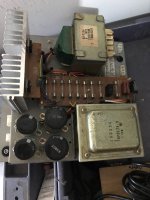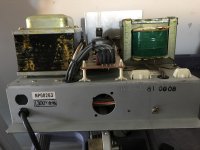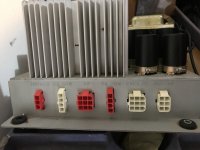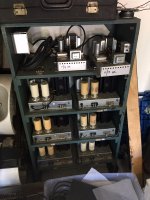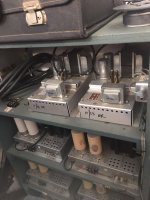Nothing I've repaired.
if you're going to sell them on e-bay or something, the voltage on the mains caps, those big black round things, would be valuable information. The "30w" and "60w" labeling indicates they are not worth a lot except as a parts source for heat sinks, power transformers, etc.
if you're going to sell them on e-bay or something, the voltage on the mains caps, those big black round things, would be valuable information. The "30w" and "60w" labeling indicates they are not worth a lot except as a parts source for heat sinks, power transformers, etc.
I only did a very quick google, but they appear to be Asian, and I would start buy researching the part numbers on the two transformers. MY first impression was Yamaha, but could be anything.
If you want to sell them to DIY types, then you ought to power them up and determine the voltages coming out the transformer secondaries.
If you want to sell them to DIY types, then you ought to power them up and determine the voltages coming out the transformer secondaries.
I've replaced expired electrolytic caps on an Allen S100 amp from 1990. This may be as you say a DC power supply, since there is only one pair of output transistors visible. No input buffer or driver stage board is visible.
The output voltage usually is 105% to 125% of the voltage rating of the main caps, as I said above.
Allen is noted for 25 year life e-caps, extremely adequate heat sinks and power transformer ratings, to allow almost continuous full power performance. Repairmen say the caps "never need replacing". Which I will argue with since the church I assist suffered a silent service in the 26th year of their model 300 organ. Rail caps were allowing 2 watts from the 100 w amp after a day's recovery.
One caveat, Allen schematics are proprietary, copyrighted, not for sale, and component repair is severly discouraged. Allen spares are available at the chassis or board level, and their "servicemen" are trained only to determine which board or chassis is at fault.
Edit, the connectors appear to be AMP mate-n-lock II or the molex equivalent. AMP will have that logo cast in almost invisibly.
The output voltage usually is 105% to 125% of the voltage rating of the main caps, as I said above.
Allen is noted for 25 year life e-caps, extremely adequate heat sinks and power transformer ratings, to allow almost continuous full power performance. Repairmen say the caps "never need replacing". Which I will argue with since the church I assist suffered a silent service in the 26th year of their model 300 organ. Rail caps were allowing 2 watts from the 100 w amp after a day's recovery.
One caveat, Allen schematics are proprietary, copyrighted, not for sale, and component repair is severly discouraged. Allen spares are available at the chassis or board level, and their "servicemen" are trained only to determine which board or chassis is at fault.
Edit, the connectors appear to be AMP mate-n-lock II or the molex equivalent. AMP will have that logo cast in almost invisibly.
Last edited:
There is still a market for Allen chassis & boards. Many organs are still installed in churches. The authorized servicemen can't touch the "bootleg repaired" chassis, they were supposed to be thrown away. Their parts have to come from the factory.Do any of you know of someone who would buy up some of this stuff? I even have small parts still in the bags.
You can get some visibility on craigslist, but e-bay is more usual sales site. The rack of chassis under this one appear to be S100 amps. Describe as supplies for Allen organ showing the picture, not implying that they came from Allen. Don't use Allen as an adjective. Allen has a very active legal department.
I'm assisting the donation of a 1990 Allen organ this month, actually. Free. Works. Our fallback plan if something besides the PS or power amp fails (repairable usually), is to convert it to midi with a key scanner board, to drive a PC.
Are these sitting at your shelves? Or are they rack mount? For which purpose?
Best regards!
The man who was the repair tech made this rack up for what I don’t know, I have all these little bags of diode’s and resistors and all kinds different little parts and I also have about a half dozen of circuit boards that went into the Allen and other brand organs
I just have all the stuff that I know that works and I don’t want to scrap it I’d rather it go to someone who can use it for what it was intended for or four projects or something. Your right that these are Allen s100 amps. I think I have about 10 of them. Can I simply plug an rca and hook up a speaker to these s100’s and use the like any other amp?
I just have all the stuff that I know that works and I don’t want to scrap it I’d rather it go to someone who can use it for what it was intended for or four projects or something. Your right that these are Allen s100 amps. I think I have about 10 of them. Can I simply plug an rca and hook up a speaker to these s100’s and use the like any other amp?
Last edited:
some S100 amps you just hook up a speaker & plug in a .5- 2 v signal and it works.
Some S100's have a high impedance input suitable for a organ pedal CDS cell drive, and have to be modified to be used with a mixer. The cds cell is in the feedback loop of an op amp. Designed to make use of regular PA amps as a replacement uneconomic.
The circuit boards can have unique parts sought out by non-authorized organ repairmen. 1970-1990 digital Allen organs used a proprietary IC from Rockwell aerospace available nowhere else. This was in the tone generation area.
The power supplies would gain value on e-bay if you figured out where the 120 vac went in, plugged them in, and figured out what voltages came out. Usual suspects are 24 v for relay drive, +-15 for linear circuits, maybe 5 v or 12 v for cmos logic.
To answer Kay P question, the chassis were screwed to the bottom (amp) or underside of the key shelf (power supply) of a hardwood organ case, with sheet metal screws. I think maple or cherry was the usual, not a really hard wood. Not compatible with 19" telephone relay/PA equipment racks.
Some S100's have a high impedance input suitable for a organ pedal CDS cell drive, and have to be modified to be used with a mixer. The cds cell is in the feedback loop of an op amp. Designed to make use of regular PA amps as a replacement uneconomic.
The circuit boards can have unique parts sought out by non-authorized organ repairmen. 1970-1990 digital Allen organs used a proprietary IC from Rockwell aerospace available nowhere else. This was in the tone generation area.
The power supplies would gain value on e-bay if you figured out where the 120 vac went in, plugged them in, and figured out what voltages came out. Usual suspects are 24 v for relay drive, +-15 for linear circuits, maybe 5 v or 12 v for cmos logic.
To answer Kay P question, the chassis were screwed to the bottom (amp) or underside of the key shelf (power supply) of a hardwood organ case, with sheet metal screws. I think maple or cherry was the usual, not a really hard wood. Not compatible with 19" telephone relay/PA equipment racks.
Last edited:
- Status
- This old topic is closed. If you want to reopen this topic, contact a moderator using the "Report Post" button.
- Home
- Live Sound
- Instruments and Amps
- Help ID Organ Amp
